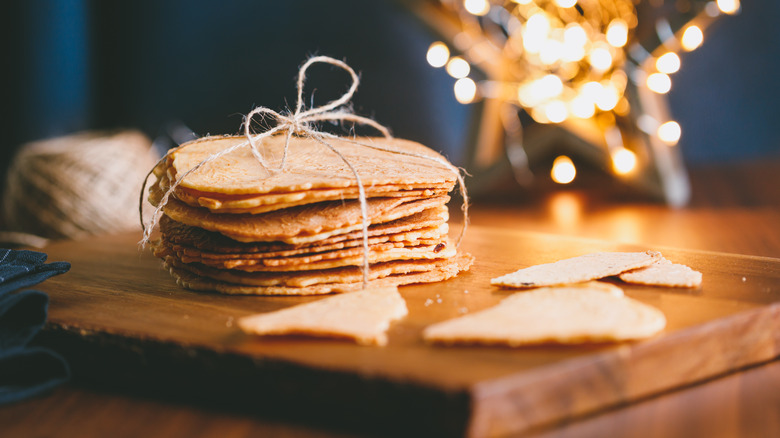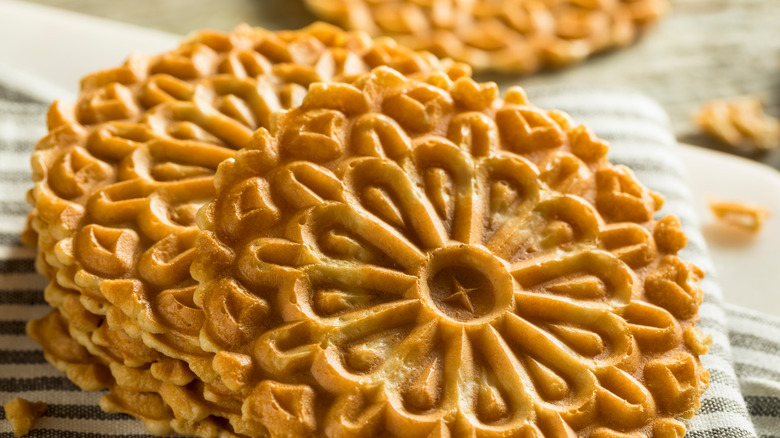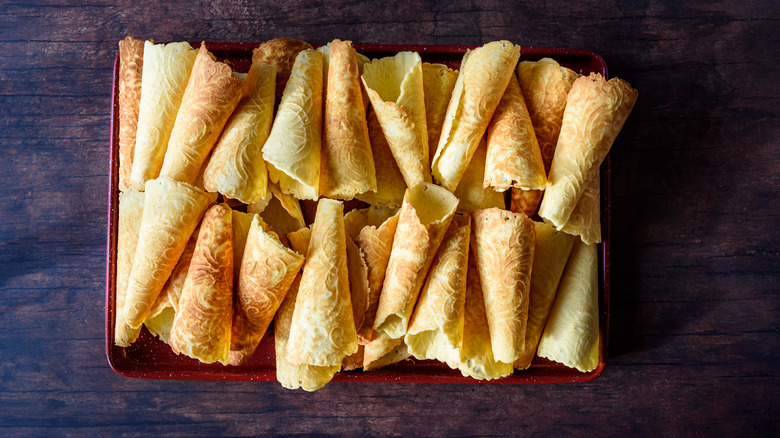Krumkake Vs. Pizzelles: What's The Difference?
The waffle is the ultimate dessert-for-breakfast food, with the ability to be sweet or savory, soft or chewy. There are many different types of waffles, but in Belgium, recognized as the hotspot for the batter-made treat, the dish falls under two particular categories. You can order Brussels waffles, which come light and a little crispy, or Liege waffles, baked with pearl sugar to a thick, chewy consistency (via Chicago Waffles).
Yet while waffles are most popular in Belgium, two other European countries remain contenders in the same game. Italy and Norway are known for their inspired versions of waffle-adjacent treats that come a little flatter — but a lot crunchier — than traditional iterations. Italian pizzelles are made with a basic, sweet batter and crisped to flat cookies, per She Loves Biscotti, while krumkake is known as a Norwegian classic (via Unicorns in the Kitchen).
Both pizzelles and krumkake are trademark treats in their respective countries of origin. These cookie-waffle hybrids may seem fairly similar to each other, but they have some differences to note.
What makes pizzelles different?
You know those thin, textured, and golden cookies that surface every holiday season? The ones that look like flattened waffle cones? Those treats are pizzelles: crispy, buttery Italian cookies traditionally flavored with anise (via King Arthur Baking Company). While some people trace the origins of pizzelles back to eighth-century Rome, the cookies have undeniably become common festive treats around the United States.
Pizzelles are made with a simple batter of eggs, sugar, salt, vanilla, flour, butter, and baking powder. With this mix as your base, you can then get experimental; traditional recipes utilize anise seed or extract, but you can also opt to incorporate butter rum, lemon, or rum flavors instead. Without additions, the dessert itself has a relatively neutral — but delicious — taste. Perhaps the cookie is best characterized by its decorative, almost lace-like texture.
If you're making the Italian treats from home — and planning to do so frequently — picking up a pizzelle maker is your best bet for consistently beautiful and tasty batches. Luckily, the appliance has multiple purposes, not all exclusive to the flat cookies. You can also use your pizzelle iron to concoct your own Choco Taco-inspired ice cream sandwich, or, as Culinary Hill recommends, get creative with homemade cannoli shells.
What makes krumkake different?
Head north of Italy, and you'll encounter a similar, but not quite the same, textured, waffle-like cookie. Krumkaker, as they are called in the plural form, are Norwegian waffle iterations made from a fairly standard batter of flour, butter, eggs, milk, vanilla, salt, and sugar (per Allrecipes). The treat appropriately gets its name from the Norwegian term for "curved cake"; the crispy cookie comes in the shape of a cone.
Herein lies the key physical difference between krumkake and pizzelles. Like pizzelles, krumkaker are made using a specific iron... but once flattened, they are immediately rolled using a mold, per Taste of Home. This process differs from that of pizzelles, which come flat and ready off the iron. Because of its shape, krumkake can also be stuffed with your choice of filling; for example, you can add whipped cream, but the sky — or rather, the cone — is truly the limit.
Moreover, krumkake and pizzelles not only look different but also taste different, thanks to varying textures and batter thickness. Krumkake batter is thinner than that of pizzelles, resulting in a cookie capable of that final rolling stage. With its delicate texture, curved shape, and versatility when it comes to flavor and fillings, the Norwegian treat stands out. But both krumkaker and pizzelles distinguish themselves among all the European waffle variations.


